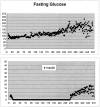Insulin independence following isolated islet transplantation and single islet infusions
- PMID: 12796569
- PMCID: PMC1514687
- DOI: 10.1097/01.SLA.0000072110.93780.52
Insulin independence following isolated islet transplantation and single islet infusions
Abstract
Objective: To restore islet function in patients whose labile diabetes subjected them to frequent dangerous episodes of hypoglycemic unawareness, and to determine whether multiple transplants are always required to achieve insulin independence.
Summary background data: The recent report by the Edmonton group documenting restoration of insulin independence by islet transplantation in seven consecutive patients with type 1 diabetes differed from previous worldwide experience of only sporadic success. In the Edmonton patients, the transplanted islet mass critical for success was approximately more than 9,000 IEq/kg of recipient body weight and required two or three separate transplants of islets isolated from two to four cadaveric donors. Whether the success of the Edmonton group can be recapitulated by others, and whether repeated transplants using multiple donors will be a universal requirement for success have not been reported.
Methods: The authors report their treatment with islet transplantation of nine patients whose labile type 1 diabetes was characterized by frequent episodes of dangerous hypoglycemia.
Results: In each of the seven patients who have completed the treatment protocol (i.e., one or if necessary a second islet transplant), insulin independence has been achieved. In five of the seven patients only a single infusion of islets was required. To date, only one recipient has subsequently lost graft function, after an initially successful transplant. This patient suffered recurrent hyperglycemia 9 months after the transplant.
Conclusions: This report confirms the efficacy of the Edmonton immunosuppressive regimen and indicates that insulin independence can often be achieved by a single transplant of sufficient islet mass.
Figures





Comment in
-
Transplantation of the pancreas and pancreatic islets: has it lived up to its promise?Curr Surg. 2005 May-Jun;62(3):305-10. doi: 10.1016/j.cursur.2004.11.015. Curr Surg. 2005. PMID: 15890213 No abstract available.
References
-
- Kelly W, Lillehei R, Merkel F, et al. Allotransplantation of the pancreas and duodenum along with the kidney in diabetic nephropathy. Surgery. 1967; 61: 827–837. - PubMed
-
- Gruessner AC, Sutherland DER. Pancreas transplant outcome for United State (US) cases reported to the United Network for Organ Sharing (UNOS) and non-US cases reported to the International Pancreas Transplant Registry (IPTR) as of October 2000. Clin Transplant. 2000; 4: 45–72. - PubMed
-
- Kendall DM, Robertson RP. Pancreas and islet transplantation in humans. Diabetes Metab Rev. 1996; 22: 157–163. - PubMed
-
- Solders G, Tyden G, Tibell A, et al. Improvement in nerve conduction 8 years after combined pancreatic and renal transplantation. Transplant Proc. 1995; 27: 3091. - PubMed
-
- Sutherland DER. Effects of pancreas transplants on secondary complications of diabetes: Review of observations at a single institution. Transplant Proc. 1992; 24: 859–860. - PubMed
Publication types
MeSH terms
Substances
Grants and funding
LinkOut - more resources
Full Text Sources
Other Literature Sources
Medical

